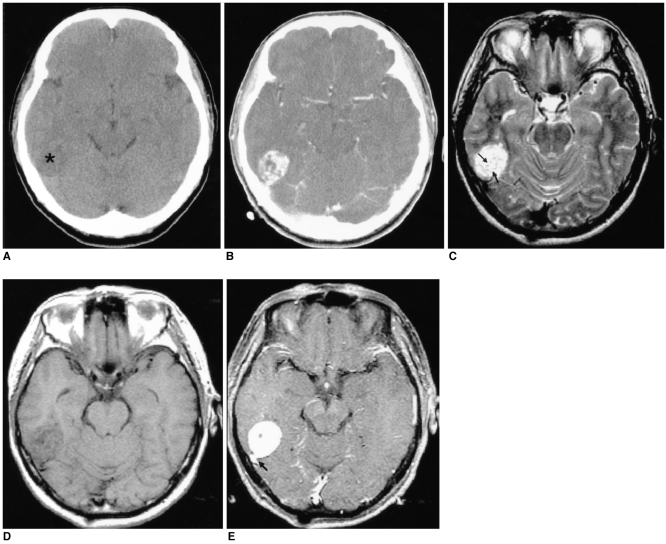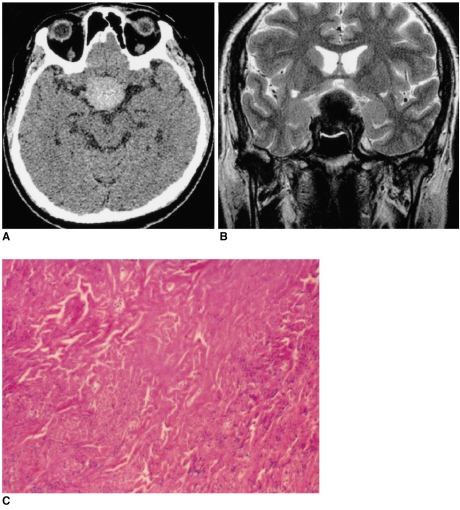Korean J Radiol.
2005 Sep;6(3):136-142. 10.3348/kjr.2005.6.3.136.
MR Imaging of Solitary Fibrous Tumors in the Head and Neck
- Affiliations
-
- 1Department of Radiology, Daejeon St. Mary's Hospital, College of Medicine, The Catholic University, Korea. rad_1970@yahoo.co.kr
- 2Department of Radiology, Asan Medical Center, University of Ulsan College of Medicine, Korea.
- 3Department of Radiology, Chonnam National University Medical School, Korea.
- 4Department of Radiology, Samsung Medical Center, Sungkyunkwan University School of Medicine, Korea.
- 5Department of Radiology, Ulsan University Hospital, University of Ulsan College of Medicine, Korea.
- 6Department of Diagnostic Pathology, Asan Medical Center, University of Ulsan College of Medicine, Korea.
- KMID: 1102709
- DOI: http://doi.org/10.3348/kjr.2005.6.3.136
Abstract
OBJECTIVE
Solitary fibrous tumor (SFT) is a very rare tumor. The purpose of this study is to determine the MR imaging features of SFT in the intracranial and extracranial head and neck regions. MATERIALS AND METHODS: We retrospectively reviewed six MR images and two CT images of six histologically proven cases of SFT that occurred in four men and two women, and their ages ranged from 46 to 59 years. These imaging findings were correlated with the microscopic findings of their surgical specimens. RESULTS: Six SFTs arose in the meninges (the petrous ridge and the pituitary fossa), the parotid gland, the parapharyngeal space, the buccal space and the maxillary sinus. On the MR images, SFTs in the intracranial and extracranial head and neck regions were mostly isointense to the muscle on the T1-weighted images, they were hyperintense on the T2-weighted images and they all had intense enhancement. On the T1- and T2-weighted images, hypointense lines were observed within in five SFTs. On the CT images, the SFTs were hypodense to the muscle on the unenhanced images and they were heterogeneously enhanced on the contrast-enhanced images. An exceptional case of pituitary SFT was hypointense on the T2-weighted images and it was hyperdense on the unenhanced CT images, which correlated with the increased collagenous component and the cellular compactness. CONCLUSION: The imaging features of SFT are nonspecific; however, SFT should be included in the differential diagnosis of masses involving the intracranial and extracranial head and neck regions.
MeSH Terms
Figure
Cited by 2 articles
-
A Case of Solitary Fibrous Tumor in the Cheek
Hak Geon Kim, Dong Hoon Kang, Jung Soo Kim, Sung Jae Heo
J Rhinol. 2018;25(1):43-46. doi: 10.18787/jr.2018.25.1.43.Malignant Solitary Fibrous Tumor of the Parotid Gland
Dae Hwan Kim, Ki Ju Cho, Jin Pyeong Kim, Seung Hoon Woo
Korean J Otorhinolaryngol-Head Neck Surg. 2017;60(10):522-526. doi: 10.3342/kjorl-hns.2016.16719.
Reference
-
1. Klemperer P, Rabin CB. Primary neoplasms of the pleura: a report of five cases. Arch Pathol. 1931; 11:385–412.
Article2. England DM, Hochholzer L, McCarthy MJ. Localized benign and malignant tumors of the pleura. A clinicopathologic review of 223 cases. Am J Surg Pathol. 1989; 13:640–658. PMID: 2665534.3. Dervan PA, Tobin B, O'Connor M. Solitary (localized) fibrous mesothelioma: evidence against mesothelial cell origin. Histopathology. 1986; 10:867–875. PMID: 2428726.
Article4. Goodlad JR, Fletcher CD. Solitary fibrous tumor arising at unusual sites: analysis of a series. Histopathology. 1991; 19:515–522. PMID: 1786936.5. Shin JH, Sung IY, Suh JH, Yang SO, Jeong YK, Lee JH, et al. Solitary fibrous tumor in the buccal space: MR Findings with pathologic correlation. AJNR Am J Neuroradiol. 2001; 22:1890–1892. PMID: 11733322.6. Jeong AK, Lee HK, Kim SY, Cho KJ. Solitary fibrous tumor of the parapharyngeal space: MR imaging findings. AJNR Am J Neuroradiol. 2002; 23:473–475. PMID: 11901021.7. Kim TA, Brunberg JA, Pearson JP, Ross DA. Solitary fibrous tumor of the paranasal sinuses: CT and MR appearance. AJNR Am J Neuroradiol. 1996; 17:1767–1772. PMID: 8896635.8. Martin AJ, Fisher C, Igbaseimokumo U, Jarosz JM, Dean AF. Solitary fibrous tumor of the meninges: case series and literature review. J Neurooncol. 2001; 54:57–69. PMID: 11763424.9. Ferretti GR, Chiles C, Cox JE, Choplin RH, Coulomb M. Localized benign fibrous tumors of the pleura: MR appearance. J Comput Assist Tomogr. 1997; 21:115–120. PMID: 9022782.
Article10. Kransdorf MJ, Jelinek JS, Moser RP Jr, Utz JA, Hudson TM, Neal J, et al. Magnetic resonance appearance of fibromatosis. A report of 14 cases and review of the literature. Skeletal Radiol. 1990; 19:495–499. PMID: 2255947.11. Pizzolitto S, Falconieri G, DeMaglio G. Solitary fibrous tumor of the spinal cord: a clinicopathologic study of two cases. Annals of Diagnostic Pathology. 2004; 8:268–275. PMID: 15494932.
Article12. Kessler A, Lapinsky J, Berenholz L, Sarfaty S, Segal A. Solitary fibrous tumor of the nasal cavity. Otolaryngol Head Neck Surg. 1999; 121:826–888. PMID: 10580246.
Article13. Sato J, Asakura K, Yokoyama Y, Satoh M. Solitary fibrous tumor of the parotid gland extending to the parapharyngeal space. Eur Arch Otorhinolaryngol. 1998; 255:18–21. PMID: 9592669.
Article14. Lee KS, Im J-G, Choe KO, Kim CJ, Lee BH. CT findings in benign fibrous mesothelioma of the pleura: pathologic correlation in nine patients. AJR Am J Roentgenol. 1992; 158:983–986. PMID: 1566702.
Article




